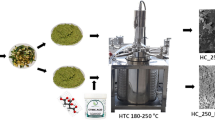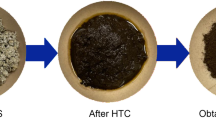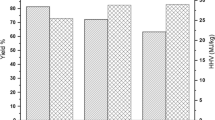Abstract
Hydrothermal carbonization (HTC) has emerged as a promising technology for sustainable use and waste valorization. One major challenge of HTC technology is the process water (PW) disposal or reuse, which is rich in dissolved organic carbon. This study evaluated the (i) potential of HTC to transform sugarcane industry by-products (sugarcane bagasse and vinasse) into useful materials for energy purposes, after, (ii) carry out the PW reuse in a novel HTC process with sugarcane bagasse. Relationships among composition, structure and morphology with fuel properties of hydrochars were evaluated. All hydrochars had lower volatile matter and higher fixed carbon content compared to the raw biomass. In addition, the decrease of H/C and O/C atomic ratios indicated an enhancement of the dehydration and deoxygenation reactions. Furthermore, the higher heating values (HHV) of hydrochars were in the range of 21.10–23.78 MJ kg-1, compared to 15.43 MJ kg-1 of the sugarcane bagasse. This result added to those from the van Krevelen diagram showed that the hydrochars presented fuel properties similar to conventional non-renewable energy sources, such as bituminous coal. Overall, the PW reuse did not promote great differences in the hydrochar properties and, consequently, no big changes on their fuel properties. Further, the hydrochar produced with sugarcane bagasse, vinasse, and sulfuric acid showed the highest heating value, and it was the most hydrophobic hydrochar among the others investigated. Therefore, the present study showed HTC and PW reuse as promising methods to treat the sugarcane industry by-products for solid fuel production.



Similar content being viewed by others
References
Berge ND, Li L, Flora JRV, Ro KS (2015) Assessing the environmental impact of energy production from hydrochar generated via hydrothermal carbonization of food wastes. Waste Manag 43:203–217. https://doi.org/10.1016/j.wasman.2015.04.029
Fang J, Zhan L, Sik Y, Gao B (2018) Minireview of potential applications of hydrochar derived from hydrothermal carbonization of biomass. J Ind Eng Chem 57:15–21. https://doi.org/10.1016/j.jiec.2017.08.026
Libra JA, Ro KS, Kammann C, Funke A, Berge ND, Neubauer Y, Titirici MM, Fühner C, Bens O, Kern J, Emmerich KH (2011) Hydrothermal carbonization of biomass residuals: a comparative review of the chemistry, processes and applications of wet and dry pyrolysis. Biofuels 2:71–106. https://doi.org/10.4155/bfs.10.81
Funke A, Ziegler F (2010) Hydrothermal carbonization of biomass: A summary and discussion of chemical mechanisms for process engineering. Biofuels Bioprod Biorefining 4:160–177. https://doi.org/10.1002/bbb.198
dos Santos JV, Fregolente LG, Moreira AB, Ferreira OP, Mounier S, Viguier B, Hajjoul H, Bisinoti MC (2020) Humic-like acids from hydrochars: study of the metal complexation properties compared with humic acids from anthropogenic soils using PARAFAC and time-resolved fluorescence. Sci Total Environ 722:137815. https://doi.org/10.1016/j.scitotenv.2020.137815
Bisinoti MC, Moreira AB, Melo CA, et al (2019) Application of carbon-based nanomaterials as fertilizers in soils. Nanomater Appl Environ Matrices 305–333. doi:https://doi.org/10.1016/B978-0-12-814829-7.00008-2
Fregolente LG, Miguel TBAR, de Castro Miguel E et al (2018) Toxicity evaluation of process water from hydrothermal carbonization of sugarcane industry by-products. Environ Sci Pollut Res 26:1–11. https://doi.org/10.1007/s11356-018-1771-2
Bento LR, Castro AJR, Moreira AB, Ferreira OP, Bisinoti MC, Melo CA (2019) Release of nutrients and organic carbon in different soil types from hydrochar obtained using sugarcane bagasse and vinasse. Geoderma 334:24–32. https://doi.org/10.1016/J.GEODERMA.2018.07.034
Kruse A, Funke A, Titirici MM (2013) Hydrothermal conversion of biomass to fuels and energetic materials. Curr Opin Chem Biol 17:515–521. https://doi.org/10.1016/j.cbpa.2013.05.004
Sevilla M, Fuertes AB (2009) The production of carbon materials by hydrothermal carbonization of cellulose. Carbon N Y 47:2281–2289. https://doi.org/10.1016/j.carbon.2009.04.026
Laranja MJ, da Silva RCJ, Bisinoti MC, Moreira AB, Boscolo M, Ferreira OP, de Almeida Melo C (2020) Factorial design of experiments for extraction and screening analysis of organic compounds in hydrochar and its process water of sugar cane bagasse and vinasse. Biomass Convers Biorefinery. https://doi.org/10.1007/s13399-020-01035-y
Silva CC, Melo CA, Soares Junior FH, Moreira AB, Ferreira OP, Bisinoti MC (2017) Effect of the reaction medium on the immobilization of nutrients in hydrochars obtained using sugarcane industry residues. Bioresour Technol 237:213–221. https://doi.org/10.1016/j.biortech.2017.04.004
Zhou N, Chen H, Feng Q, Yao D, Chen H, Wang H, Zhou Z, Li H, Tian Y, Lu X (2017) Effect of phosphoric acid on the surface properties and Pb(II) adsorption mechanisms of hydrochars prepared from fresh banana peels. J Clean Prod 165:221–230. https://doi.org/10.1016/j.jclepro.2017.07.111
Vieira LHS, Sganzerla Sabino CM, Soares Júnior FH, Rocha JS, Castro MO, Alencar RS, Souza da Costa L, Viana BC, Jardim de Paula A, Soares JM, Gomes Souza Filho A, Otubo L, Fechine PBA, Ghosh A, Ferreira OP (2020) Strategic design of magnetic carbonaceous nanocomposites and its application as multifunctional adsorbent. Carbon N Y 161:758–771. https://doi.org/10.1016/j.carbon.2020.01.089
Fang J, Gao B, Chen J, Zimmerman AR (2015) Hydrochars derived from plant biomass under various conditions: characterization and potential applications and impacts. Chem Eng J 267:253–259. https://doi.org/10.1016/j.cej.2015.01.026
Fregolente LG, dos Santos JV, Mazzati FS, et al (2021) Hydrochar from sugarcane industry by-products: assessment of its potential use as a soil conditioner by germination and growth of maize. Chem Biol Technol Agric 8:1–13. https://doi.org/10.1186/s40538-021-00210-1
Fregolente LG, dos Santos JV, Vinci G, Piccolo A, Moreira AB, Ferreira OP, Bisinoti MC, Spaccini R (2021) Insights on molecular characteristics of hydrochars by 13 C-NMR and off-line TMAH-GC / MS and assessment of their potential use as plant growth promoters. Molecules 26:1–16. https://doi.org/10.3390/molecules26041026
Bento LR, Melo CA, Ferreira OP, Moreira AB, Mounier S, Piccolo A, Spaccini R, Bisinoti MC (2020) Humic extracts of hydrochar and Amazonian Dark Earth: molecular characteristics and effects on maize seed germination. Sci Total Environ 708:135000. https://doi.org/10.1016/j.scitotenv.2019.135000
Yang F, Zhang S, Cheng K, Antonietti M (2019) A hydrothermal process to turn waste biomass into artificial fulvic and humic acids for soil remediation. Sci Total Environ 686:1140–1151. https://doi.org/10.1016/j.scitotenv.2019.06.045
Tasca AL, Puccini M, Gori R, Corsi I, Galletti AMR, Vitolo S (2019) Hydrothermal carbonization of sewage sludge: a critical analysis of process severity, hydrochar properties and environmental implications. Waste Manag 93:1–13. https://doi.org/10.1016/j.wasman.2019.05.027
UNICA (2019) Acompanhamento quinzenal da safra na região Centro-Sul: Posição até 16/07/2018. Dep Econ e Estatística 15
Karp SG, Woiciechowski AL, Soccol VT, Soccol CR (2013) Pretreatment strategies for delignification of sugarcane bagasse: a review. Braz Arch Biol Technol 56:679–689. https://doi.org/10.1590/S1516-89132013000400019
Fregolente LG, de Castro AJR, Moreira AB et al (2019) New proposal for sugarcane vinasse treatment by hydrothermal carbonization: an evaluation of solid and liquid products. J Braz Chem Soc 00:1–11
Melo CA, Junior FHS, Bisinoti MC, Moreira AB, Ferreira OP (2017) Transforming sugarcane bagasse and vinasse wastes into hydrochar in the presence of phosphoric acid: an evaluation of nutrient contents and structural properties. Waste Biomass Valoriz 8:1139–1151. https://doi.org/10.1007/s12649-016-9664-4
Costa RS, Vieira LHS, Ghosh A et al (2019) Hydrothermal carbonization of waste babassu coconut biomass for solid fuel production. Rev Virtual Quim 11:626–641. https://doi.org/10.21577/1984-6835.20190048
Wu K, Gao Y, Zhu G, Zhu J, Yuan Q, Chen Y, Cai M, Feng L (2017) Characterization of dairy manure hydrochar and aqueous phase products generated by hydrothermal carbonization at different temperatures. J Anal Appl Pyrolysis 127:335–342. https://doi.org/10.1016/j.jaap.2017.07.017
Liu H, Chen Y, Yang H, Gentili FG, Söderlind U, Wang X, Zhang W, Chen H (2019) Hydrothermal carbonization of natural microalgae containing a high ash content. Fuel 249:441–448. https://doi.org/10.1016/j.fuel.2019.03.004
Lee J, Sohn D, Lee K, Park KY (2019) Solid fuel production through hydrothermal carbonization of sewage sludge and microalgae Chlorella sp. from wastewater treatment plant. Chemosphere 230:157–163. https://doi.org/10.1016/j.chemosphere.2019.05.066
Başakçılardan Kabakcı S, Baran SS (2019) Hydrothermal carbonization of various lignocellulosics: fuel characteristics of hydrochars and surface characteristics of activated hydrochars. Waste Manag 100:259–268. https://doi.org/10.1016/j.wasman.2019.09.021
Espana-Gamboa E, Mijangos-Cortes J, Barahona-Perez L et al (2011) Vinasses: characterization and treatments. Waste Manag Res 29:1235–1250. https://doi.org/10.1177/0734242X10387313
Christofoletti CA, Escher JP, Correia JE, Marinho JFU, Fontanetti CS (2013) Sugarcane vinasse: environmental implications of its use. Waste Manag 33:2752–2761. https://doi.org/10.1016/j.wasman.2013.09.005
de Souza Dias MO, Maciel Filho R, Mantelatto PE et al (2015) Sugarcane processing for ethanol and sugar in Brazil. Environ Dev 15:35–51. https://doi.org/10.1016/j.envdev.2015.03.004
Kabadayi Catalkopru A, Kantarli IC, Yanik J (2017) Effects of spent liquor recirculation in hydrothermal carbonization. Bioresour Technol 226:89–93. https://doi.org/10.1016/j.biortech.2016.12.015
Laranja MJ, da Silva RCJ, Bisinoti MC, Moreira AB, Ferreira OP, Melo CA (2020) Semivolatile organic compounds in the products from hydrothermal carbonisation of sugar cane bagasse and vinasse by gas chromatography-mass spectrometry. Bioresour Technol Rep 12:100594. https://doi.org/10.1016/j.biteb.2020.100594
Weiner B, Poerschmann J, Wedwitschka H, Koehler R, Kopinke FD (2014) Influence of process water reuse on hydrothermal carbonization of paper. Sustain Chem Eng 2:2165–2171. https://doi.org/10.1021/sc500348v
Kambo HS, Minaret J, Dutta A (2017) Process water from the hydrothermal carbonization of biomass: a waste or a valuable product? Waste Biomass Valoriz 9:1–9. https://doi.org/10.1007/s12649-017-9914-0
Stemann J, Putschew A, Ziegler F (2013) Hydrothermal carbonization: process water characterization and effects of water recirculation. Bioresour Technol 143:139–146. https://doi.org/10.1016/j.biortech.2013.05.098
ASTM (2013) ASTM D1762-84. Standard test method for chemical analysis of wood charcol. Annu B ASTM Stand 84:292–293. https://doi.org/10.1520/D1762-84R07.2
ASTM (2012) ASTM D-5865. American society for testing and materials – standard test method for determination for gross calorific value of coal and coke. doi:https://doi.org/10.1520/D5865-13
Santana A, Bisinoti M, Melo C et al (2019) Disponibilidade De Nutrientes E Carbono Orgânico Em Solos Contendo Carvão Hidrotérmico Lavado E Não Lavado E Comparação Com Solos Antropogênicos. Quim Nova 42:262–272. https://doi.org/10.21577/0100-4042.20170339
Lisperguer J, Perez P, Urizar S (2009) Structure and thermal properties of lignins: characterization by infrared spectroscopy and differential scanning calorimetry. J Chil Chem Soc 54:460–463. https://doi.org/10.4067/S0717-97072009000400030
Lua AC, Yang T (2004) Effect of activation temperature on the textural and chemical properties of potassium hydroxide activated carbon prepared from pistachio-nut shell. J Colloid Interface Sci 274:594–601. https://doi.org/10.1016/j.jcis.2003.10.001
Srinivasan P, Sarmah AK, Smernik R, Das O, Farid M, Gao W (2015) A feasibility study of agricultural and sewage biomass as biochar, bioenergy and biocomposite feedstock: Production, characterization and potential applications. Sci Total Environ 512–513:495–505. https://doi.org/10.1016/j.scitotenv.2015.01.068
Kang S, Li X, Fan J, Chang J (2012) Characterization of hydrochars produced by hydrothermal carbonization of lignin, cellulose, d-xylose, and wood meal. Ind Eng Chem Res 51:9023–9031. https://doi.org/10.1021/ie300565d
Ding W, Dong X, Ime IM, Gao B, Ma LQ (2014) Pyrolytic temperatures impact lead sorption mechanisms by bagasse biochars. Chemosphere 105:68–74. https://doi.org/10.1016/j.chemosphere.2013.12.042
Singh B, Fang Y, Johnston CT (2016) A Fourier-transform infrared study of biochar aging in soils. Soil Sci Soc Am J 80:613–622. https://doi.org/10.2136/sssaj2015.11.0414.A
Gao Y, Wang X, Wang J, Li X, Cheng J, Yang H, Chen H (2013) Effect of residence time on chemical and structural properties of hydrochar obtained by hydrothermal carbonization of water hyacinth. Energy 58:376–383. https://doi.org/10.1016/j.energy.2013.06.023
Liu F, Yu R, Ji X, Guo M (2018) Hydrothermal carbonization of holocellulose into hydrochar: structural, chemical characteristics, and combustion behavior. Bioresour Technol 263:508–516. https://doi.org/10.1016/j.biortech.2018.05.019
Wang T, Zhai Y, Zhu Y, Gan X, Zheng L, Peng C, Wang B, Li C, Zeng G (2018) Evaluation of the clean characteristics and combustion behavior of hydrochar derived from food waste towards solid biofuel production. Bioresour Technol 266:275–283. https://doi.org/10.1016/j.biortech.2018.06.093
Mestre AS, Tyszko E, Andrade MA, Galhetas M, Freire C, Carvalho AP (2015) Sustainable activated carbons prepared from a sucrose-derived hydrochar: remarkable adsorbents for pharmaceutical compounds. RSC Adv 5:19696–19707. https://doi.org/10.1039/c4ra14495c
Saqib NU, Baroutian S, Sarmah AK (2018) Physicochemical, structural and combustion characterization of food waste hydrochar obtained by hydrothermal carbonization. Bioresour Technol 266:357–363. https://doi.org/10.1016/j.biortech.2018.06.112
Tekin K, Karagöz S, Bektaş S (2014) A review of hydrothermal biomass processing. Renew Sust Energ Rev 40:673–687. https://doi.org/10.1016/j.rser.2014.07.216
Posmanik R, Martinez CM, Cantero-Tubilla B, Cantero DA, Sills DL, Cocero MJ, Tester JW (2018) Acid and alkali catalyzed hydrothermal liquefaction of dairy manure digestate and food waste. ACS Sustain Chem Eng 6:2724–2732. https://doi.org/10.1021/acssuschemeng.7b04359
Méndez A, Gascó G, Ruiz B, Fuente E (2019) Hydrochars from industrial macroalgae “Gelidium Sesquipedale” biomass wastes. Bioresour Technol 275:386–393. https://doi.org/10.1016/j.biortech.2018.12.074
Funding
This work was supported by the São Paulo Research Foundation (FAPESP) (grants 15/22954-1, 17/26718-6, and 18/15733-7). J.V.S acknowledges a scholarship from FAPESP (grants 17/05408-9 and 18/09914-9). O.P.F. acknowledges financial support from Fundação Cearense de Apoio ao Desenvolvimento Científico e Tecnológico (FUNCAP) through the Grants “PRONEX PR2-0101-00006.01.00/15” and “Rational Design of Nanomaterials and Applications in Environmental Remediation, Agriculture and Health” and also to Conselho Nacional de Desenvolvimento Científico e Tecnológico (CNPq) through the Grant 313637/2019-9 (CNPq DT 29/2019). M.C.B. acknowledges financial support from Conselho Nacional de Desenvolvimento Científico e Tecnológico (CNPq) through the Grant 303377/2019-4. The authors thank Dr. Maurício Boscolo for offering assistance with the FTIR analysis (FAPESP, grant 2017/13230-5).
Author information
Authors and Affiliations
Corresponding author
Ethics declarations
Conflict of interest
The authors declare no competing interests.
Additional information
Publisher’s Note
Springer Nature remains neutral with regard to jurisdictional claims in published maps and institutional affiliations.
Supplementary Information
ESM 1
(DOCX 102 kb)
Rights and permissions
About this article
Cite this article
dos Santos, J.V., Fregolente, L.G., Laranja, M.J. et al. Hydrothermal carbonization of sugarcane industry by-products and process water reuse: structural, morphological, and fuel properties of hydrochars. Biomass Conv. Bioref. 12, 153–161 (2022). https://doi.org/10.1007/s13399-021-01476-z
Received:
Revised:
Accepted:
Published:
Issue Date:
DOI: https://doi.org/10.1007/s13399-021-01476-z




